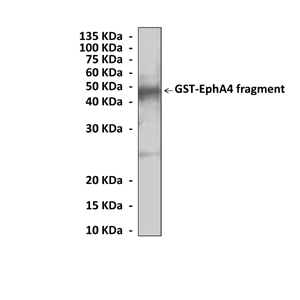Anti-EphA4: Mouse EphA4 Antibody |
 |
BACKGROUND Eph family of receptor tyrosine kinases consists of at least 14 distinct receptors and has eight membrane-bound ligands, known as the ephrins. This is the largest family of receptor tyrosine kinases. Eph proteins are divided into two subfamilies: the EphA receptors (A1-A8) that bind glycosyl phosphatidylinositol (GPI)-linked ephrin-A ligands (A1-A5), and the EphB receptors (B1-B6) that bind transmembrane ephrin-B ligands (B1-B3). The only known crosstalk between the A and B subfamilies occurs with the EphA4 receptor, which can bind ephrins-B2 and -B3 as well as the entire A subclass. There is a great deal of redundancy of receptor-ligand binding specificity within each subfamily, although binding affinities vary.1,2 Both GPI-anchoredephrinA and transmembrane ephrinB ligands interact with the Nterminal globular domain (Glob) of Eph receptors. The Eph receptors become phosphorylated at specific tyrosine residues in the cytoplasmic domain following ligand binding. Phosphorylated motifs serve as sites of interaction with certain cytoplasmic signaling proteins to mediate downstream signaling. In addition, through their C terminus the Eph receptors associate with PDZ (postsynaptic density protein, disc large, zona occludens) domain-containing proteins. Moreover, Eph receptor contact induces tyrosine phosphorylation of the cytoplasmic domain of ephrinB proteins via an SRC-family kinase (SFK), which mediating the reverse signaling. One of the unique features of Eph/ephrin signaling is the fact that both receptors and ligands are competent to transduce a signaling cascade upon interaction. Eph-activated signaling is termed forward, and ephrin-activated signaling is termed reverse. Another level of complexity stems from the fact that interactions between Eph receptors and ephrins can happen in trans (between two opposing cells) or in cis (within the same cell). It is commonly assumed that trans interactions are activating while cis interactions are inhibiting.3 Eph-Ephrin signaling functions in a variety biological processes including diverse assegmentation of the somites and rhombomeres, the formation of blood vessels, Axon guidance and fasciculation, migration of the neural crest and metastasis of transformed cells etc.
EphA4 has a non-cell-autonomous role, not requiring EphA4 forward signaling in the formation of the anterior commissure (AC), an axon bundle that connects the two cerebral hemispheres. EphA4 is also required for development of the thalamocortical system, where complementary gradients of EphA4 in the thalamic primary somatosensory (ventrobasal [VB]) nucleus, and ephrinA5 in the somatosensory area (S1) of the cortex, control topographic mapping of thalamocortical axons. Moreover,, EphA4 is required for corticospinal tract (CST) axons to recognize the spinal cord midline as an intermediate repulsive target that prevents them from aberrantly recrossing. Furthermore, EphA4-positive neurons are key components of the spinal central pattern generator (CPG), a local neuronal network within the spinal cord that is rhythmically active during locomotion. In addition, EphA4 influences the selection of ipsilateral vs. contralateral targets in the chick auditory brainstem and mice lacking EphA4 have mirror movements in the limbs resulting from aberrant crossing of corticothalamic projections. It was demonstrated that EphA4 inhibits induction of ipsilateral VCN-MNTB projections.4 Finally, EphA4 were highly and selectively expressed in T cells of patients with Sézary syndrome (Sz). Thus, the membrane-bound EphA4 receptor may serve as a target for directed therapeutic intervention.5
EphA4 has a non-cell-autonomous role, not requiring EphA4 forward signaling in the formation of the anterior commissure (AC), an axon bundle that connects the two cerebral hemispheres. EphA4 is also required for development of the thalamocortical system, where complementary gradients of EphA4 in the thalamic primary somatosensory (ventrobasal [VB]) nucleus, and ephrinA5 in the somatosensory area (S1) of the cortex, control topographic mapping of thalamocortical axons. Moreover,, EphA4 is required for corticospinal tract (CST) axons to recognize the spinal cord midline as an intermediate repulsive target that prevents them from aberrantly recrossing. Furthermore, EphA4-positive neurons are key components of the spinal central pattern generator (CPG), a local neuronal network within the spinal cord that is rhythmically active during locomotion. In addition, EphA4 influences the selection of ipsilateral vs. contralateral targets in the chick auditory brainstem and mice lacking EphA4 have mirror movements in the limbs resulting from aberrant crossing of corticothalamic projections. It was demonstrated that EphA4 inhibits induction of ipsilateral VCN-MNTB projections.4 Finally, EphA4 were highly and selectively expressed in T cells of patients with Sézary syndrome (Sz). Thus, the membrane-bound EphA4 receptor may serve as a target for directed therapeutic intervention.5
REFERENCES
1. Brantley-Sieders, D.M. & Chen, J.: Angiogenesis. 7:17, 2004
2. Murai, K.K. & Pasquale, E.B.: J. Cell Sci. 116:2823, 2003
3. Arvanitis, D. & Davy, A.: Genes & Dev. 22:416, 2008
4. Hsieh, C.Y. et al: J. Comparat. Neurol. 504:508-18, 2007
5. van Doorn, R. et al: Cancer Res. 64:5578-86, 2004
2. Murai, K.K. & Pasquale, E.B.: J. Cell Sci. 116:2823, 2003
3. Arvanitis, D. & Davy, A.: Genes & Dev. 22:416, 2008
4. Hsieh, C.Y. et al: J. Comparat. Neurol. 504:508-18, 2007
5. van Doorn, R. et al: Cancer Res. 64:5578-86, 2004
Products are for research use only. They are not intended for human, animal, or diagnostic applications.
Параметры
Cat.No.: | CP10303 |
Antigen: | Raised against recombinant human EphA4 fragments expressed in E. coli. |
Isotype: | Mouse IgG1 |
Species & predicted species cross- reactivity ( ): | Human, Mouse, Rat |
Applications & Suggested starting dilutions:* | WB 1:1000 IP n/d IHC n/d ICC n/d FACS n/d |
Predicted Molecular Weight of protein: | 135 kDa |
Specificity/Sensitivity: | Detects EphA4 proteins without cross-reactivity with other family members. |
Storage: | Store at -20°C, 4°C for frequent use. Avoid repeated freeze-thaw cycles. |
*Optimal working dilutions must be determined by end user.
Документы
Информация представлена исключительно в ознакомительных целях и ни при каких условиях не является публичной офертой








